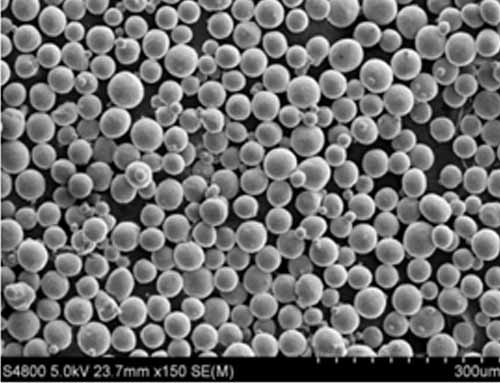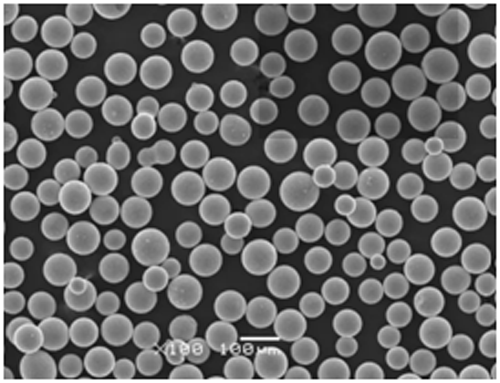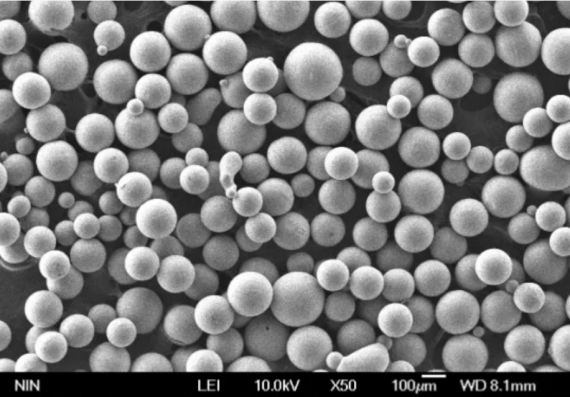FeCoNiCr, 고엔트로피 합금(HEA)인 이 합금은 뛰어난 특성으로 인해 첨단 제조, 재료 과학 및 산업 분야에서 두각을 나타내고 있습니다. 다재다능함과 강력한 성능으로 알려진 이 금속 합금 분말은 철(Fe), 코발트(Co), 니켈(Ni) 및 크롬(Cr)으로 구성됩니다. 엔지니어, 연구원 또는 제조업체이든 FeCoNiCr 분말을 이해하면 프로세스 및 응용 분야를 혁신할 수 있습니다.
이 기사에서는 FeCoNiCr 분말의 구성, 특성, 응용 분야, 장점 및 제한 사항에 대해 자세히 살펴보겠습니다. 또한 다양한 모델과 등급을 비교하고, 공급업체 옵션을 논의하고, 자주 묻는 질문에 답변해 드리겠습니다.

FeCoNiCr 분말 개요
FeCoNiCr 분말은 거의 동일한 비율의 다원소 시스템인 고엔트로피 합금 계열에 속합니다. 이러한 고유한 구성은 중요한 엔지니어링 응용 분야에서 매우 바람직한 특성인 뛰어난 강도, 내식성, 열적 안정성 및 피로 저항성을 제공합니다.
한눈에 보는 주요 세부 정보
| 속성 | 세부 정보 |
|---|---|
| 요소 | 철(Fe), 코발트(Co), 니켈(Ni), 크롬(Cr) |
| 카테고리 | 고엔트로피 합금(HEA) |
| 애플리케이션 | 항공우주, 자동차, 생체 의학, 공구, 에너지 저장 |
| 강점 | 우수한 기계적 특성, 열적 안정성 및 내식성 |
| 제작 방법 | 분말 야금, 적층 제조 및 열 분사 |
FeCoNiCr 분말의 구성
FeCoNiCr 분말의 구성은 구성 금속의 거의 등몰 비율을 포함합니다. 그러나 구성을 약간 변경하면 특정 재료 특성을 얻을 수 있습니다. 다음은 세부 정보입니다.
| 구성 | 원소 함량(wt%) | 역할 |
|---|---|---|
| 철(Fe) | 20-25 | 기본 강도와 연성을 제공합니다. |
| 코발트 (Co) | 20-25 | 자기 및 내마모성을 향상시킵니다. |
| 니켈(Ni) | 20-25 | 내식성 및 인성을 향상시킵니다. |
| 크롬(Cr) | 20-25 | 산화 저항성 및 경도를 추가합니다. |
의 특성 FeCoNiCr 분말
FeCoNiCr 분말이 특별한 이유는 무엇일까요? 다음은 그 특성에 대한 자세한 내용입니다.
| 특징 | 설명 |
|---|---|
| 열 안정성 | 고온에서 기계적 특성을 유지하여 항공우주 응용 분야에 이상적입니다. |
| 내식성 | 산화에 대한 우수한 저항성으로 가혹한 환경에 적합합니다. |
| 높은 경도 | 우수한 내마모성으로 도구 및 부품의 수명을 연장합니다. |
| 자기 속성 | 특히 코발트와 철 함량이 있는 응용 분야에서 강력한 자기적 특성을 나타냅니다. |
| 사용자 지정 기능 | 특정 응용 분야에 맞게 원소 비율을 조정할 수 있습니다. |






FeCoNiCr 분말의 장점
다른 합금 대신 FeCoNiCr 분말을 선택하는 이유는 무엇일까요? 다음은 차별화되는 요소입니다.
- 뛰어난 내구성: FeCoNiCr은 고응력 환경에서 많은 기존 합금보다 뛰어납니다.
- 애플리케이션의 다양성: 항공우주에서 생체 의학에 이르기까지 다양한 분야에 적용됩니다.
- 비용 효율적인 프로덕션: 분말 야금은 폐기물을 줄여 재료 사용을 최적화합니다.
- 친환경적: 부품 수명이 길어지면 재료 및 에너지 소비가 줄어듭니다.
FeCoNiCr 분말 모델 및 등급
다양한 FeCoNiCr 분말 모델은 다양한 산업 및 응용 분야에 적합합니다. 다음은 10가지 주목할 만한 모델입니다.
| 모델 | 설명 |
|---|---|
| FeCoNiCr-Al | 고온 응용 분야를 위한 향상된 열적 안정성. |
| FeCoNiCr-Mn | 해양 환경을 위한 향상된 내식성. |
| FeCoNiCr-Ti | 더 높은 강도와 경량 응용 분야를 위한 티타늄 첨가. |
| FeCoNiCr-WC | 공구의 극심한 내마모성을 위한 탄화 텅스텐 첨가. |
| FeCoNiCr-BN | 윤활 및 내마모성을 위한 붕소 질화물 강화. |
| FeCoNiCr-Cu | 더 나은 전기 전도성을 위한 구리 포함. |
| FeCoNiCr-Nb | 항공우주 부품의 석출 경화를 위한 니오븀 첨가. |
| FeCoNiCr-Zr | 우수한 산화 저항성을 위한 지르코늄 함량. |
| FeCoNiCr-Si | 가공성 및 산화 저항성을 향상시키기 위한 실리콘 첨가. |
| FeCoNiCr-Ce | 향상된 자기 및 열적 특성을 위한 희토류 원소. |
애플리케이션 FeCoNiCr 분말
FeCoNiCr 분말은 다재다능함과 우수한 특성으로 인해 여러 산업 분야에서 사용됩니다.
| 산업 | 애플리케이션 | 특정 이점 |
|---|---|---|
| 항공우주 | 제트 엔진 부품, 터빈 블레이드 | 높은 열적 안정성 및 피로 저항성. |
| 자동차 | 엔진 부품, 배기 시스템 | 내식성 및 고온 성능. |
| 바이오메디컬 | 임플란트, 보철 | 생체 적합성 및 내마모성. |
| 툴링 | 절삭 공구, 금형 | 극심한 경도 및 내마모성. |
| 에너지 | 배터리 전극, 연료 전지 | 높은 전기 전도성 및 안정성. |
사양, 크기 및 등급
| 매개변수 | 세부 정보 |
|---|---|
| 입자 크기 범위 | 10–150 µm |
| 순도 수준 | 99% |
| 표준 충족 | ASTM F75, ISO 5832-1 |
| 패키징 옵션 | 1kg, 5kg, 25kg |
| 사용 가능한 성적 | 표준, 초순수, 맞춤형 구성 |
공급업체 및 가격 세부 정보
| 공급업체 | 지역 | 가격(대략) | 특별 기능 |
|---|---|---|---|
| 카펜터 기술 | 미국 | $100–$120/kg | 맞춤형 합금 제형을 제공합니다. |
| 호가나스 AB | 스웨덴 | $90–$110/kg | 분말 야금 재료의 선두 주자입니다. |
| 샌드빅 머티리얼즈 | 글로벌 | $95–$125/kg | 고순도 및 안정적인 공급망. |
| AMETEK Specialty | 미국 | $105–$130/kg | 항공우주 등급 합금에 중점을 둡니다. |
| VDM 금속 | 독일 | $110–$140/kg | 고품질 분말 표준으로 유명합니다. |

장단점 FeCoNiCr 분말
| 측면 | 장점 | 단점 |
|---|---|---|
| 성능 | 뛰어난 내열성 및 내식성 | 기존 합금에 비해 높은 비용. |
| 사용자 지정 기능 | 필요에 맞게 조정된 원소 구성 | 고급 제조 기술이 필요합니다. |
| 내구성 | 가혹한 조건에서 긴 수명 | 기존 합금에 비해 제한적인 지식 기반. |
자주 묻는 질문
| 질문 | 답변 |
|---|---|
| FeCoNiCr 분말은 어디에 사용됩니까? | 항공우주 부품, 생체 의학 임플란트, 공구 및 에너지 저장. |
| FeCoNiCr 분말은 어떻게 만들어집니까? | 고급 분말 야금, 적층 제조 또는 열 분사를 통해. |
| 구성을 사용자 정의할 수 있습니까? | 예, 특정 특성을 최적화하기 위해 원소 비율을 조정할 수 있습니다. |
| FeCoNiCr 분말의 주요 장점은 무엇입니까? | 높은 강도, 내식성 및 우수한 열적 안정성. |
| FeCoNiCr 분말은 친환경적입니까? | 예, 부품 수명이 길어지고 재료 폐기물이 줄어듭니다. |
| 어떤 산업 분야에서 FeCoNiCr 분말에 의존합니까? | 항공우주, 자동차, 생체 의학, 공구 및 에너지 부문. |
| FeCoNiCr 분말의 대안이 있습니까? | 예, 다른 고엔트로피 합금 또는 Inconel 또는 Hastelloy와 같은 기존의 초합금. |
| FeCoNiCr은 Inconel과 어떻게 비교됩니까? | FeCoNiCr은 더 나은 맞춤화 기능과 유사한 열 및 내식성을 제공합니다. |
| FeCoNiCr 분말의 평균 비용은 얼마입니까? | 순도 및 공급업체에 따라 킬로그램당 $90에서 $140 사이입니다. |
| FeCoNiCr 분말을 사용하는 데 어떤 어려움이 있습니까? | 기존 합금에 비해 생산 비용이 높고 과거 데이터가 제한적입니다. |

